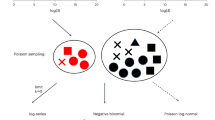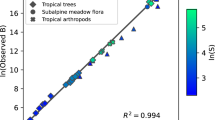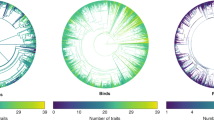Abstract
The term ‘biodiversity’ is a simple contraction of ‘biological diversity’, and at first sight the concept is simple too: biodiversity is the sum total of all biotic variation from the level of genes to ecosystems. The challenge comes in measuring such a broad concept in ways that are useful. We show that, although biodiversity can never be fully captured by a single number, study of particular facets has led to rapid, exciting and sometimes alarming discoveries. Phylogenetic and temporal analyses are shedding light on the ecological and evolutionary processes that have shaped current biodiversity. There is no doubt that humans are now destroying this diversity at an alarming rate. A vital question now being tackled is how badly this loss affects ecosystem functioning. Although current research efforts are impressive, they are tiny in comparison to the amount of unknown diversity and the urgency and importance of the task.
This is a preview of subscription content, access via your institution
Access options
Subscribe to this journal
Receive 51 print issues and online access
$199.00 per year
only $3.90 per issue
Buy this article
- Purchase on Springer Link
- Instant access to full article PDF
Prices may be subject to local taxes which are calculated during checkout




Similar content being viewed by others
References
Whittaker, R. H. Evolution and measurement of species diversity. Taxon 21, 213–251 (1972).
Magurran, A. E. Ecological Diversity and its Measurement (Croom Helm, London, 1988).
Balmford, A., Green, M. J. B. & Murray, M. G. Using higher-taxon richness as a surrogate for species-richness: I. Regional tests. Proc. R. Soc. Lond. B 263, 1267–1274 (1996).
Sepkoski, J. J. Jr Rates of speciation in the fossil record. Proc. R. Soc. Lond. B 353, 315–326 (1998).
Pine, R. H. New mammals not so seldom. Nature 368 ( 1994).
Paxton, C. G. M. A cumulative species description curve for large open water marine animals . J. Mar. Biol. Assoc. 78, 1389– 1391 (1998).
Hawksworth, D. L. & Kalin-Arroyo, M. T. in Global Biodiversity Assessment (ed. Heywood, V. H.) 107– 191 (Cambridge Univ. Press, Cambridge, 1995).
Funch, P. & Kristensen, R. M. Cycliophora is a new phylum with affinities to Entoprocta and Ectoprocta. Nature 378, 711–714 (1995).
Fuhrman, J. A. & Campbell, L. Marine ecology: microbial microdiversity . Nature 393, 410–411 (1998).
Gross, M. Life on the Edge (Plenum, New York, 1998).
Abbott, A. Battle lines drawn between ‘nanobacteria’ researchers. Nature 401, 105 (1999).
Tristem, M. Identification and characterization of novel human endogenous retrovirus families by phylogenetic screening of the human genome mapping project database. J. Virol. 74, 3715–3730 (2000).
Kidwell, M. G. & Lisch, D. Transposable elements as sources of variation in animals and plants. Proc. Natl Acad. Sci. USA 94, 7704–7711 ( 1997).
Goddard, M. R. & Burt, A. Recurrent invasion and extinction of a selfish gene. Proc. Natl Acad. Sci. USA 96, 13880–13885 (1999).
Rylands, A. B., Mittermeier, R. A. & Luna, E. R. A species list for the New World Primates (Platyrrhini): distribution by country, endemism, and conservation status according to the Mace-Lande system. Neotrop. Primates 3S, 113–160 (1995).
Cracraft, J. Species concepts and speciation analysis. Curr. Ornithol. 1, 159–187 (1983).
Avise, J. C. & Wollenberg, K. Phylogenetics and the origin of species. Proc. Natl Acad. Sci. USA 94, 7748–7755 (1997).
Hanken, J. Why are there so many new amphibian species when amphibians are declining? Trends Ecol. Evol. 14, 7– 8 (1999).
Harvey, P. H., Leigh Brown, A. J., Maynard Smith, J. & Nee, S. New Uses for New Phylogenies (Oxford Univ. Press, Oxford, 1996).
Nee, S., Barraclough, T. G. & Harvey, P. H. in Biodiversity: A Biology of Numbers and Difference (ed. Gaston, K. J.) 230–252 (Blackwell Science, Oxford, 1996).
Pagel, M. Inferring the historical patterns of biological evolution. Nature 401, 877–884 ( 1999).
Sanderson, M. J. A nonparametric approach to estimating divergence times in the absence of rate constancy. Mol. Biol. Evol. 14, 1218 –1231 (1997).
Wang, D. Y.-C, Kumar, S. & Hedges, S. B. Divergence time estimates for the early history of animal phyla and the origin of plants, animals and fungi. Proc. R. Soc. Lond. B 266, 163–171 ( 1999).
Bromham, L., Phillips, M. J. & Penny, D. Growing up with dinosaurs: molecular dates and the mammalian radiation. Trends Ecol. Evol. 14, 113– 118 (1999).
Cooper, A. & Penny, D. Mass survival of birds across the Cretaceous-Tertiary boundary: molecular evidence. Science 275, 1109–1113 (1997).
Foote, M., Hunter, J. P., Janis, C. M. & Sepkoski, J. J. Evolutionary and preservational constraints on the origins of biological groups: divergence times of eutherian mammals. Science 283, 1310–1314 (1999).
Cooper, A. & Fortey, R. Evolutionary explosions and the phylogenetic fuse. Trends Ecol. Evol. 13, 151– 156 (1998).
Darwin, C. On the Origin of Species by Means of Natural Selection (Murray, London, 1859).
Dial, K. P. & Marzluff, J. M. Nonrandom diversification within taxonomic assemblages. Syst. Zool. 38, 26 –37 (1989).
Avise, J. C. & Johns, G. C. Proposal for a standardized temporal scheme of biological classification for extant species. Proc. Natl Acad. Sci. USA 96, 7358–7363 (1999).
Purvis, A. in New Uses for New Phylogenies (eds Harvey, P. H., Leigh Brown, A. J., Maynard Smith, J. & Nee, S.) 153–168 (Oxford Univ. Press, Oxford, 1996).
Mooers, A. Ø. & Heard, S. B. Evolutionary process from phylogenetic tree shape. Q. Rev. Biol. 72, 31–54 (1997).
Heard, S. B. & Hauser, D. L. Key evolutionary innovations and their ecological mechanisms. Hist. Biol. 10, 151–173 (1995).
Mitter, C., Farrell, B. & Wiegmann, B. The phylogenetic study of adaptive zones: has phytophagy promoted insect diversification? Am. Nat. 132, 107–128 (1988).
Marzluff, J. M. & Dial, K. P. Life history correlates of taxonomic diversity. Ecology 72, 428– 439 (1991).
Barraclough, T. G., Harvey, P. H. & Nee, S. Sexual selection and taxonomic diversity in passerine birds. Proc. R. Soc. Lond. B 259, 211– 215 (1995).
Owens, I. P. F., Bennett, P. M. & Harvey, P. H. Species richness among birds: body size, life history, sexual selection or ecology? Proc. R. Soc. Lond. B 266, 933–939 (1999).
Gardezi, T. F. & da Silva, J. Diversity in relation to body size in mammals: a comparative study. Am. Nat. 153, 110–123 ( 1999).
Gittleman, J. L. & Purvis, A. Body size and species richness in primates and carnivores. Proc. R. Soc. Lond. B 265, 113–119 (1998).
Sanderson, M. J. & Donoghue, M. J. Shifts in diversification rate with the origin of angiosperms. Science 264, 1590–1593 (1994).
Pagel, M. Inferring evolutionary processes from phylogenies. Zool. Scripta 26, 331–348 ( 1997).
Kelley, S. T. & Farrell, B. D. Is specialization a dead end? The phylogeny of host use in Dendroctonus bark beetles (Scolytidae) . Evolution 52, 1731–1743 (1998).
Harvey, P. H. & Pagel, M. D. The Comparative Method in Evolutionary Biology (Oxford Univ. Press, Oxford, 1991).
Rosenzweig, M. L. Colonial birds probably do speciate faster. Evol. Ecol. 10, 681–683 (1996).
Barraclough, T. G., Nee, S. & Harvey, P. H. Sister-group analysis in identifying correlates of diversification . Evol. Ecol. 12, 751–754 (1998).
Benton, M. J. The Fossil Record 2 (Chapman & Hall, London, 1993 ).
Sepkoski, J. J. A compendium of fossil marine families. Milwaukee Publ. Mus. Contrib. Biol. Geol. 51, 1–125 ( 1982).
Benton, M. J. Diversification and extinction in the history of life. Science 268, 52–58 ( 1995).
Courtillot, V. & Gaudemer, Y. Effects of mass extinctions on biodiversity. Nature 381, 146–148 (1996).
Benton, M. J. Models for the diversification of life. Trends Ecol. Evol. 12, 490–495 (1997).
Kirchner, J. W. & Weil, A. Delayed biological recovery from extinctions throughout the fossil record. Nature 404, 177–180 ( 2000).
Avise, J. C., Walker, D. & Johns, G. C. Speciation durations and Pleistocene effects on vertebrate phylogeography. Proc. R. Soc. Lond. B 265, 1707–1712 (1998).
Zink, R. M. & Slowinski, J. B. Evidence from molecular systematics for decreased avian diversification in the Pleistocene epoch. Proc. Natl Acad. Sci. USA 92, 5832– 5835 (1995).
Marshall, C. R. in The Adequacy of the Fossil Record (ed. Paul, C. R. C.) 23–53 (Wiley, Chichester, 1998).
Alroy, J. in Biodiversity Dynamics (eds McKinney, M. L. & Drake, J. A.) 232–287 (Columbia Univ. Press, New York, 1999).
Alroy, J. Constant extinction, constrained diversification, and uncoordinated stasis in North American mammals. Palaeogeogr. Palaeoclimatol. Palaeoecol. 127, 285–311 ( 1996).
Van Valkenburgh, B. & Janis, C. in Species Diversity in Ecological Communities (eds Ricklefs, R. E. & Schluter, D.) 330–340 (Chicago Univ. Press, Chicago, 1993).
Kauffman, E. G. & Fagerstrom, J. A. in Species Diversity in Ecological Communities (eds Ricklefs, R. E. & Schluter, D.) 315–329 (Chicago Univ. Press, Chicago, 1993).
McKinney, M. L. in Biodiversity Dynamics (eds McKinney, M. L. & Drake, J. A.) 1–16 (Columbia Univ. Press, New York, 1999).
Foote, M. in Evolutionary Paleobiology (eds Jablonski, D., Erwin, D. H. & Lipps, J. H.) 62–86 (Chicago Univ. Press, Chicago, 1996).
Roy, K. & Foote, M. Morphological approaches to measuring biodiversity. Trends Ecol. Evol. 12, 277 –281 (1997).
Schluter, D. Ecological causes of adaptive radiation. Am. Nat. 148 (Suppl.), S40–S64 ( 1996).
Barraclough, T. G., Vogler, A. P. & Harvey, P. H. Revealing the factors that promote speciation. Phil. Trans. R. Soc. Lond. B 353, 241– 249 (1998).
Barbault, R. & Sastrapradja, S. D. in Global Biodiversity Assessment (ed. Heywood, V. H.) 193–274 (Cambridge Univ. Press, Cambridge, 1995).
May, R. M., Lawton, J. H. & Stork, N. E. in Extinction Rates (eds Lawton, J. H. & May, R. M.) 1–24 (Oxford Univ. Press, Oxford, 1995).
Hughes, J. B., Daily, G. C. & Ehrlich, P. R. Population diversity: its extent and extinction. Science 278, 689–692 ( 1997).
Pimm, S. L. in Conservation Science and Action (ed. Sutherland, W. J.) 20– 38 (Blackwell Science, Oxford, 1998).
Wilson, E. O. The Diversity of Life (Norton, New York, 1992).
Grelle, C. E. d. V., Fonseca, G. A. B., Fonseca, M. T. & Costa, L. P. The question of scale in threat analysis: a case study with Brazilian mammals. Anim. Conserv. 2, 149–152 (1999).
Cowlishaw, G. Predicting the pattern of decline of African primate diversity: an extinction debt from historical deforestation. Conserv. Biol. 13, 1183–1193 (1999).
Nee, S. & May, R. M. Extinction and the loss of evolutionary history. Science 278, 692– 694 (1997).
Heard, S. B. & Mooers, A. Ø. Phylogenetically patterned speciation rates and extinction risks change the loss of evolutionary history during extinctions. Proc. R. Soc. Lond. B 267, 613–620 (2000).
Mace, G. M. & Balmford, A. in Future Priorities for the Conservation of Mammalian Diversity (eds Entwhistle, A. & Dunstone, N.) (Cambridge Univ. Press, Cambridge, 1999).
Bennett, P. M. & Owens, I. P. F. Variation in extinction risk among birds: chance or evolutionary predisposition? Proc. R. Soc. Lond. B 264, 401–408 (1997).
McKinney, M. L. Extinction vulnerability and selectivity: combining ecological and paleontological views. Annu. Rev. Ecol. Syst. 28, 495– 516 (1997).
Russell, G. J., Brooks, T. M., McKinney, M. M. & Anderson, C. G. Present and future taxonomic selectivity in bird and mammal extinctions. Conserv. Biol. 12, 1365–1376 (1998).
McKinney, M. L. Branching models predict loss of many bird and mammal orders within centuries . Anim. Conserv. 1, 159– 164 (1998).
Purvis, A., Agapow, P.-M, Gittleman, J. L. & Mace, G. M. Nonrandom extinction risk and the loss of evolutionary history. Science 288, 328–330 ( 2000).
Kunin, W. E. & Lawton, J. H. in Biodiversity: a Biology of Numbers and Difference (ed. Gaston, K. J.) 283– 308 (Blackwell Science, Oxford, 1996).
MacGillivray, C. W. et al. Testing predictions of the resistance and resilience of vegetation subjected to extreme events. Funct. Ecol. 9, 640–649 (1995).
Wardle, D. A., Zackrisson, O., Hörnberg, G. & Gallet, C. The influence of island area on ecosystem properties. Science 277, 1296–1299 (1997).
Jones, C. J., Lawton, J. H. & Shachak, M. Positive and negative effects of organisms as physical ecosystem engineers. Ecology 78, 1946– 1957 (1997).
Darwin, C. & Wallace, A. On the tendency of species to form varieties; and on the perpetuation of varieties and species by natural means of selection. J. Proc. Linn. Soc. Lond., Zool. 3, 45–62 (1858).
Tilman, D. Ecological consequences of biodiversity: a search for general principles. Ecology 80, 1455–1474 ( 1999).
Spehn, E. M., Joshi, J., Schmid, B., Diemer, M. & Körner, C. Aboveground resource use increases with plant species richness in experimental grassland ecosystems. Funct. Ecol. 14 (in the press).
Allison, G. W. The implications of experimental design for biodiversity manipulations. Am. Nat. 153, 26–45 ( 1999).
Schwartz, M. W. et al. Linking biodiversity to ecosystem functioning: implications for conservation ecology. Oecologia 122, 297–305 (2000).
Knops, J. M. H. et al. Effects of plant species richness on invasion dynamics, disease outbreaks, insect abundance and diversity. Ecol. Lett. 2, 286–294 ( 1999).
Stachowicz, J. J., Whitlatch, R. B. & Osman, R. W. Species diversity and invasion resistance in a marine ecosystem. Science 286, 1577– 1579 (1999).
Van der Heijden, M. G. A. et al. Mycorrhizal fungal diversity determines plant biodiversity, ecosystem variability and productivity. Nature 396, 69–72 (1998).
Loreau, M. Biodiversity and ecosystem functioning: a mechanistic model. Proc. Natl Acad. Sci. USA 95, 5632–5636 (1998).
Tilman, D. Diversity and production in European Grasslands. Science 286, 1099–1100 (1999).
Williams, P. H. & Humphries, C. J. in Biodiversity: A Biology of Numbers and Difference (ed. Gaston, K. J.) 54– 76 (Blackwell Scientific, Oxford, 1996).
May, R. M. in Ecology and Evolution of Communities (eds Cody, M. L. & Diamond, J. M.) 81–120 (Belknap, Cambridge, MA, 1975).
Corbet, G. B. & Hill, J. E. A World List of Mammalian Species (Natural History Museum, London, 1991).
Bisby, F. A. in Global Biodiversity Assessment (ed. Heywood, V. H.) 21– 106 (Cambridge Univ. Press, Cambridge, 1995).
Myers, N., Mittermeier, R. A., Mittermeier, C. G., de Fonseca, G. A. B. & Kent, J. Biodiversity hotspots for conservation priorities. Nature 403, 853–858 (2000).
Groombridge, J. J., Jones, C. G., Bruford, M. W. & Nichols, R. A. 'Ghost' alleles of the Mauritius kestrel. Nature 403 , 616 (2000).
Williams, P. H., Humphries, C. J. & Vane-Wright, R. I. Centres of seed-plant diversity: the family way. Proc. R. Soc. Lond. B 256, 67–70 (1994).
Mallet, J. in Biodiversity: A Biology of Numbers and Difference (ed. Gaston, K. J.) 13–53 (Blackwell Science, Oxford, 1996).
Gould, S. J. Wonderful Life: The Burgess Shale and the Nature of History (Norton, New York, 1989).
Moritz, C. Defining 'evolutionarily significant units' for conservation. Trends Ecol. Evol. 9, 373–375 (1994).
Faith, D. P. in Systematics and Conservation Evaluation (eds Forey, P. L., Humphries, C. J. & Vane-Wright, R. I.) 251–268 (Clarendon, Oxford, 1994).
Vane-Wright, R. I., Humphries, C. J. & Williams, P. H. What to protect? Systematics and the agony of choice . Biol. Conserv. 55, 235– 254 (1991).
Pressey, R. L., Johnson, I. R. & Wilson, P. D. Shades of irreplaceability: towards a measure of the contribution of sites to a reservation goal. Biodiv. Conserv. 3, 242–262 ( 1994).
Russell, G. J. in Biodiversity Dynamics (eds McKinney, M. L. & Drake, J. A.) 377–404 (Columbia Univ. Press, New York, 1999).
Grace, J. B. The factors controlling species density in herbaceous plant communities: an assessment. Persp. Plant Ecol. Evol. Syst. 2, 1–28 (1999).
Waide, R. B. et al. The relationship between productivity and species richness . Annu. Rev. Ecol. Syst. 30, 257– 300 (1999).
Acknowledgements
We thank T. Barraclough, C. Godfray, R. Grenyer, P. Harvey, C. Humphries, N. Isaac, G. Mace, A. Minns, B. Schmid and R. Vane-Wright for discussion and comments, and NERC and the EC BIODEPTH project for support.
Author information
Authors and Affiliations
Rights and permissions
About this article
Cite this article
Purvis, A., Hector, A. Getting the measure of biodiversity. Nature 405, 212–219 (2000). https://doi.org/10.1038/35012221
Issue Date:
DOI: https://doi.org/10.1038/35012221
This article is cited by
-
Singleton-based species names and fungal rarity: Does the number really matter?
IMA Fungus (2024)
-
Bathymetric Variation on the Quantitative Diversity in the Deep-sea Fish Assemblage of Southwest India, Arabian Sea
Thalassas: An International Journal of Marine Sciences (2023)
-
Ascomycetes from karst landscapes of Guizhou Province, China
Fungal Diversity (2023)
-
Quantifying ant diversity and community in a subalpine forest mosaic: a comparison of two methods
Journal of Insect Conservation (2023)
Comments
By submitting a comment you agree to abide by our Terms and Community Guidelines. If you find something abusive or that does not comply with our terms or guidelines please flag it as inappropriate.



